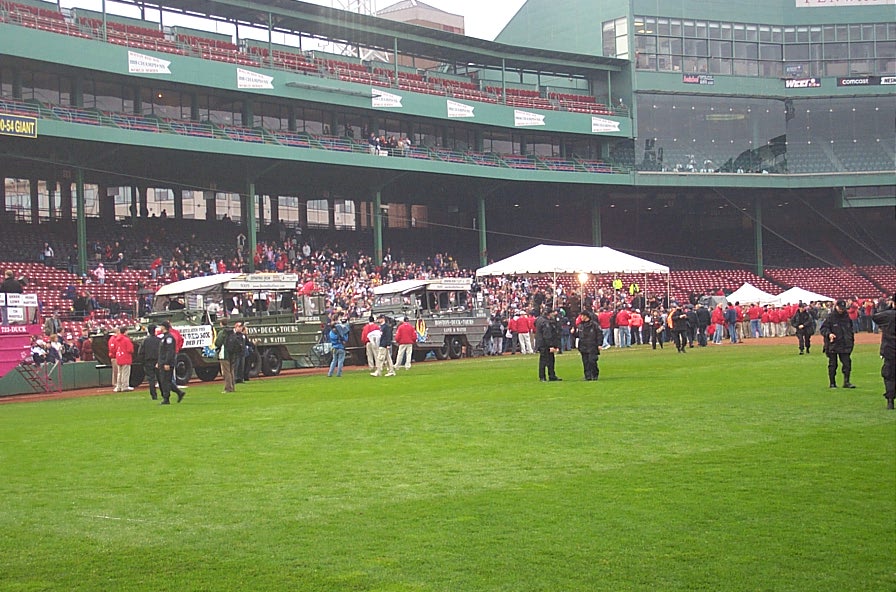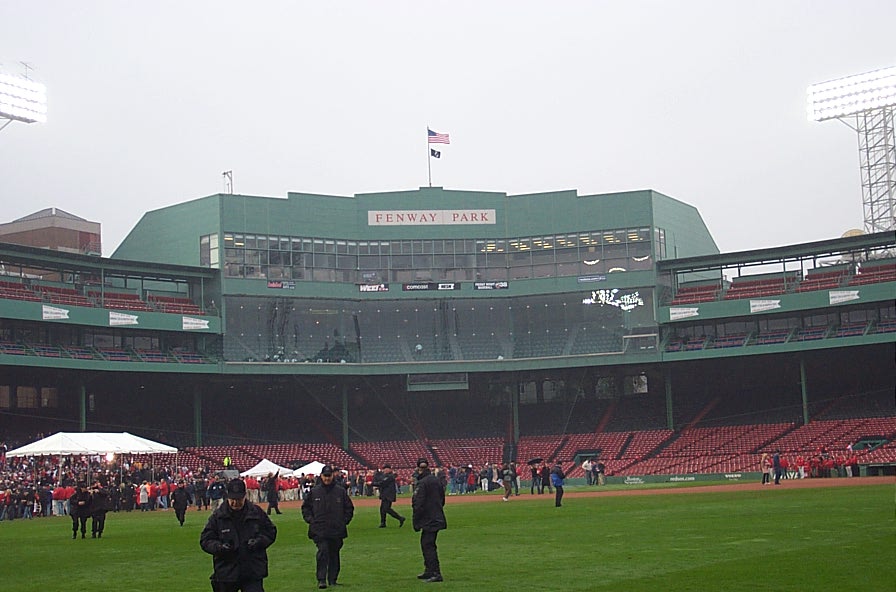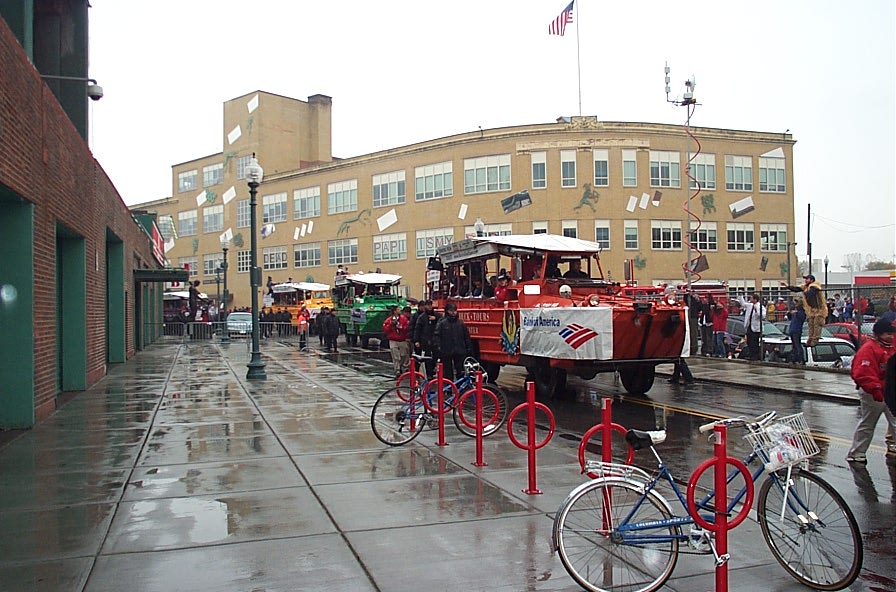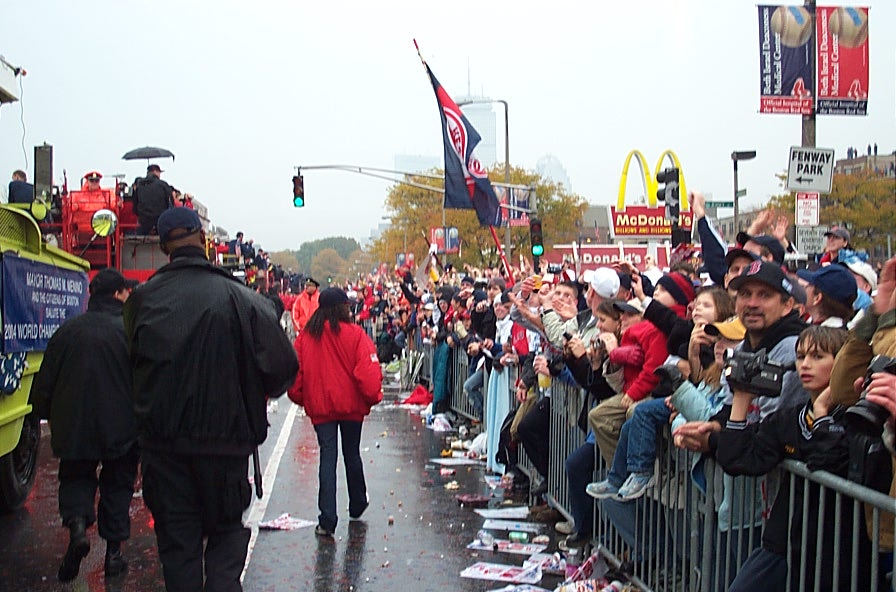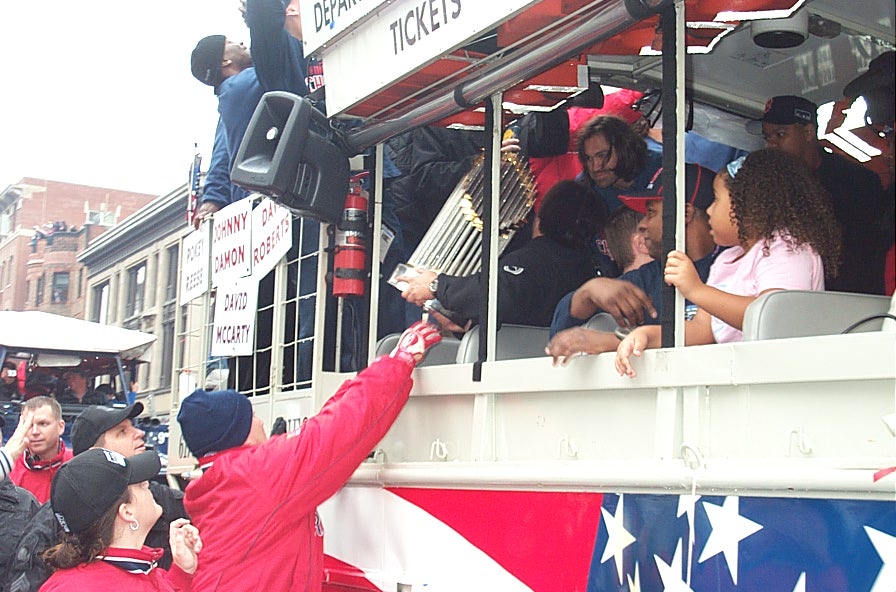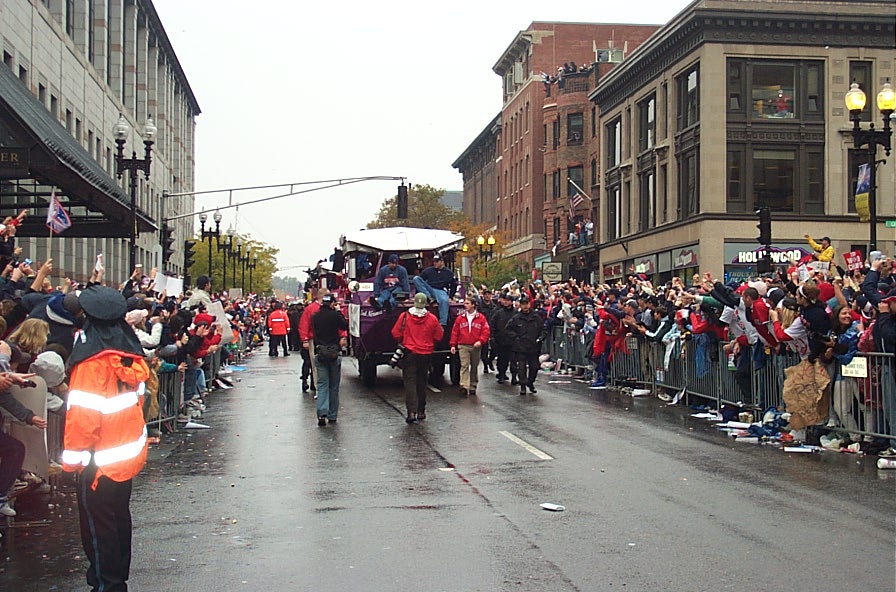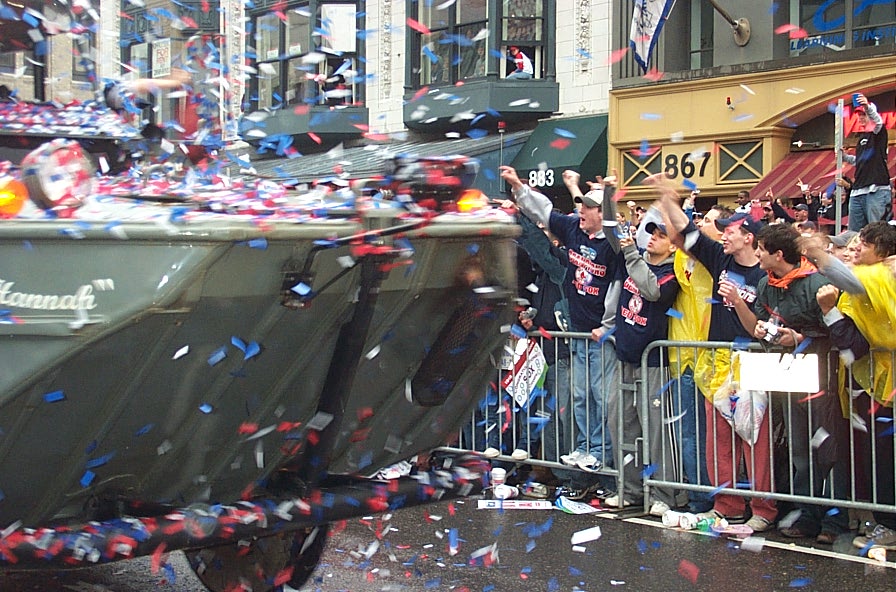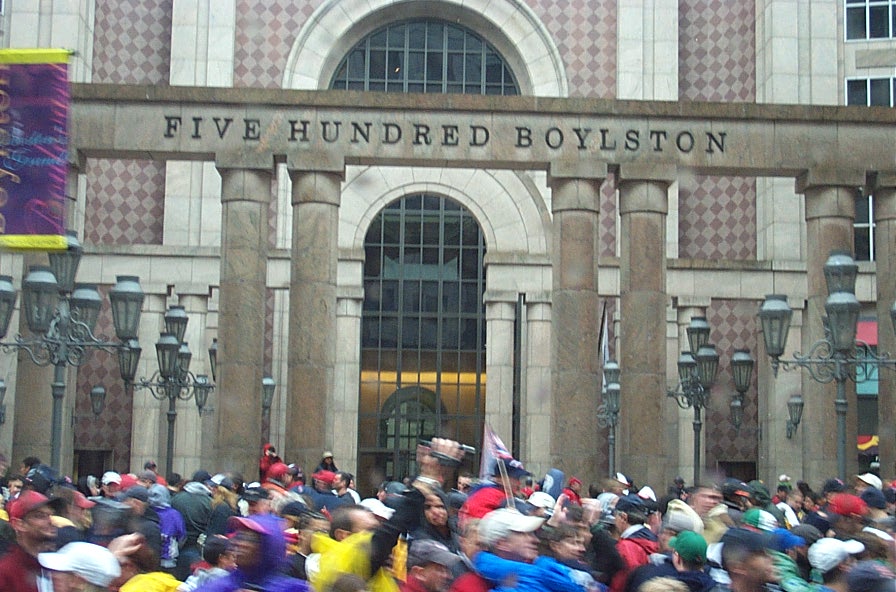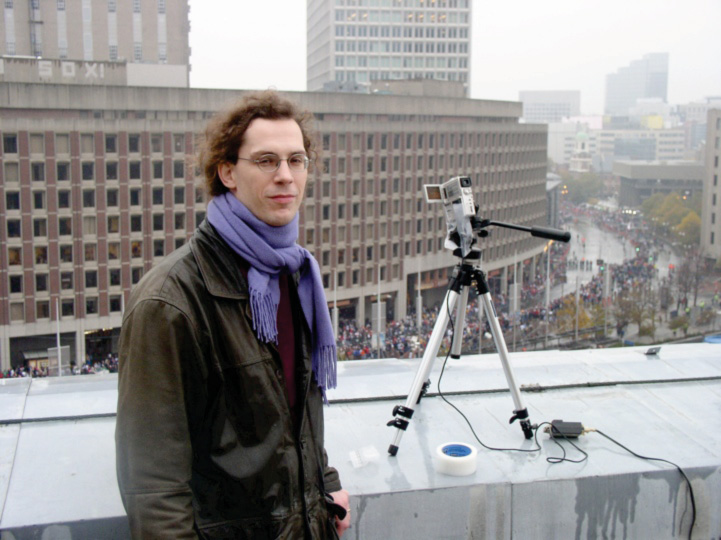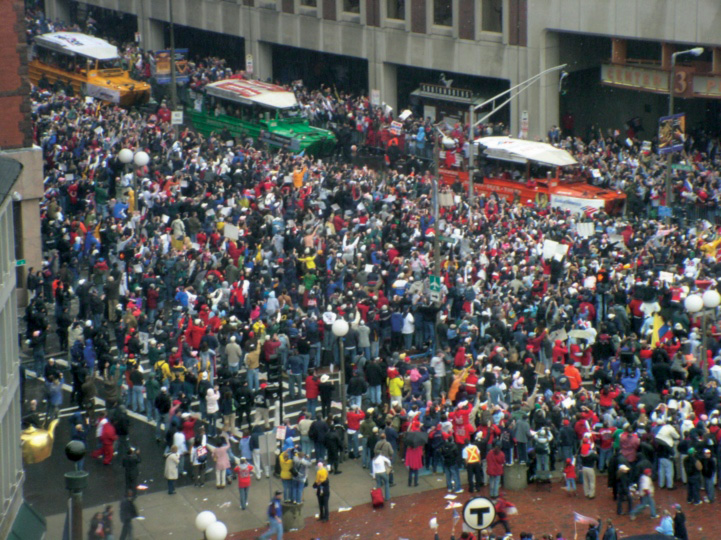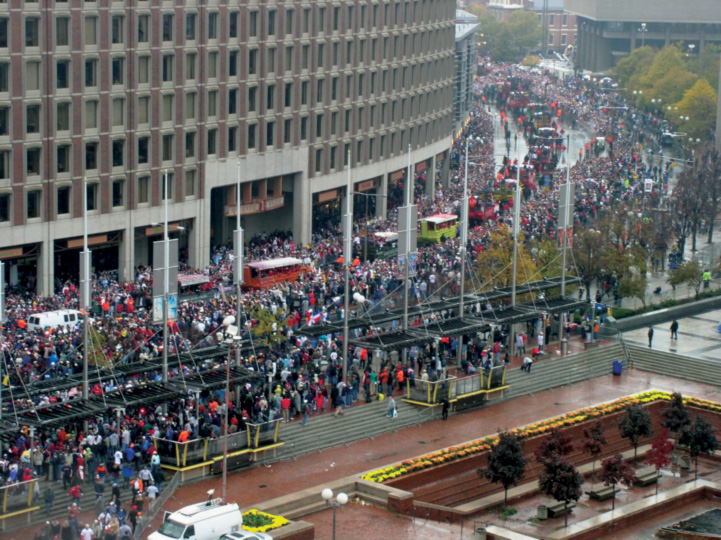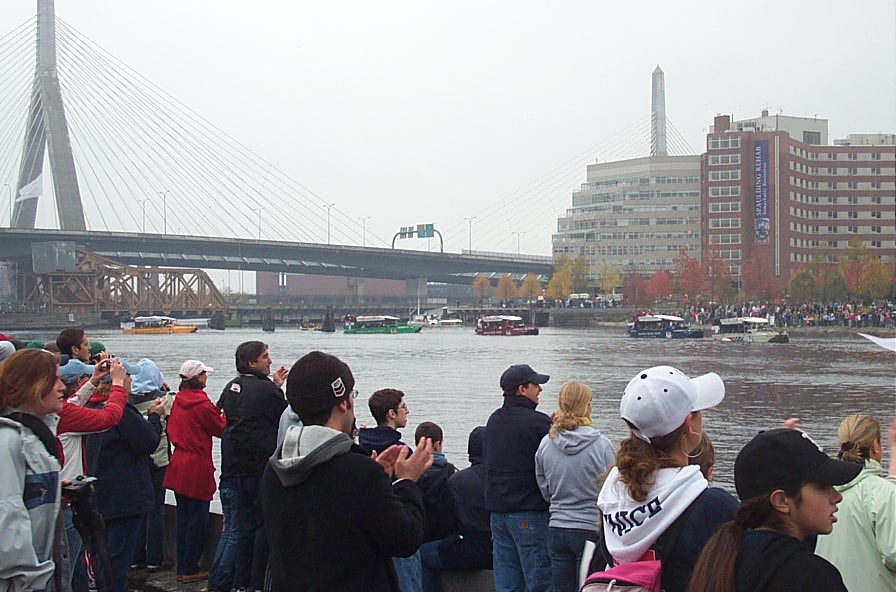October 30, 2004 - Researchers at the New England Complex Systems Institute (NECSI) who use computers to simulate crowds, today had an opportunity to see the real thing in action. NECSI postdoctoral fellow Sanith Wijesinghe was embedded with the Red Sox parade to observe the crowd behavior. The parade, reported by the Boston Globe to have attracted 3.2 million people, was one of the largest crowd events in Boston history.
Just the previous evening, the President of NECSI advised the city to extend the parade route. The city extended the route using a river course that allowed many more people to view the parade. Invited by Boston Police Commissioner Kathleen O'Toole to advise the city about the parade, Professor Yaneer Bar-Yam, President of NECSI, calculated the maximum capacity of the original route and found it far below the expected number of people.
"There was a great danger of crowd crushing causing injuries or deaths." Professor Bar-Yam explained, "We used videotapes of the Patriots championship parade to estimate the maximum crowd density, and the area of the crowd at that event. We were also sure that the Red Sox parade would be substantially bigger." With this information Bar-Yam and Wijesinghe calculated that the route along Boylston and Tremont Streets would not hold the expected crowd, "The numbers we estimated for the Patriots parade and the Red Sox parade were significantly below the ones reported by the Globe. Still, even these smaller numbers were too high for the space available."
Beginning of Red Sox parade in Fenway Park
(photo by Sanith Wijesinghe, on October 30, 2004)
They also learned from a Boston Police officer about problems that happened at the Patriots day event. The crowd crush was causing children at the front to be stuck between the barrier and the crowd. Officers would take children over the barrier in order to prevent injury. With the much greater crowds expected at the Red Sox event, the danger was great that such crowd crushing would cause injury.
"What the police officer told us was consistent with our expectations that people move forward when a parade comes by, leading to a possibility of too high pressure at the front barrier," Prof. Bar-Yam continued. "Unless something is done, there is no place for the people to go."
With people spread out over the longer route, the problems did not occur. Accompanying the parade, Wijesinghe saw that the crowd was dense but the space could hold it. "It was clear that if there were twice as many people in that space, there would have been great danger of problems. People just wouldn't have been able to move and any small problem in the crowd could have led to a crisis," he said.
From his vantage point, Wijesinghe also had a great view of the parade itself. "It was fun to be part of the parade and see the Red Sox up close.", Wijesinghe said, "Still, it was also a great opportunity to see how crowds behave. We can use what we learned to improve our models and develop better tools for understanding crowd dynamics."
The models they develop may be useful for the next Patriots championship, or when the Red Sox win the World Series again next year.
Beginning of Red Sox parade in Fenway Park
(photo by Sanith Wijesinghe, on October 30, 2004)
NECSI recommends extending route, 5:45 PM, Oct. 29th, 2004
Kathleen O'Toole
Boston Police Commissioner
Dear Kathy,
I greatly appreciate the opportunity to meet with the members of your staff that are responsible for the event tomorrow.
I would like to share with you the specific if preliminary conclusions that I reached from the discussions that we had today.
There are two issues that I find of particular concern:
1) We viewed a videotape of the Patriots Championship parade and used this to estimate the number of people in City Hall Plaza and along the route. We reached the number of approximately 250,000 people in City Hall Plaza itself (see note 1 below), and we also roughly estimate an additional 100,000-150,000 along the route. we obtain a total of 350,000-400,000 for the patriots parade. This total is significantly below official estimates, though it provides a starting point for our calculations regarding the Red Sox event tomorrow. The expected number of people tomorrow at the Red Sox is about twice the Patriots parade, i.e. we will take the number 700,000. We have calculated the capacity of the planned route for the Red Sox parade at about 500,000 along the route (see note 2) plus an additional 100,000 in City Hall Plaza (less than the Patriots parade due to obstructed views) plus 100,000 in the Boston Commons. This leads to a total capacity of 700,000. Leading us to believe that the crowds will be at or exceed the capacity of the routes planned. While the specific estimates are rough, I believe it is a warning that there may very well be difficulties related to both space and police personnel in managing the crowd tomorrow.
[These are very rough estimates of capacity:
note 1: Capacity of city hall plaza: 250,000 = 10 people per square yard x 25,000 square yards fully packed.
note 2: Capacity of route: 500,000 = 8 yards per side of the road x 2 sides x 3,000 yards [2 miles of usable road] x 10 people per square yard.]
2) From our understanding of crowd behavior as well as from information provided to us from members of your staff, the greatest concern is the crush of people at the front of the crowd as the parade goes by. In the Patriots parade, we are told that police took action to allow children to cross the barrier in order not to be crushed. With the much greater numbers expected tomorrow, particularly along the route, I believe that this risk is much greater. We have discussed with members of your staff some possible strategies for allowing for pressure release at the time of the parade crossing, however, any such measures would likely require additional resources that do not appear to be available. For example, creating a pressure release space (doubling the barriers with a space in between that can be filled in a controlled way just prior to the parade itself), or creating emergency passages for access or egress running either along the route behind the crowd or perpendicular to the route that could also be collapsed in a controlled way at the time of the parade (ideally some form of pen to control number of people in an area was discussed). All of these would require additional barriers to mark the space and personnel to ensure the retention of the open area until use. Due to the need for both physical resources, i.e. barriers, and manpower resources these solutions appear impractical at the current time.
Taken together, the recognition of being at capacity and the limited resources suggests that there is a great risk. What is most of concern, as you know, is the instability of crowd dynamics. When the capacity of the space is reached, this instability is great, and in this case the capacity appears to be strained both from the point of physical space and personnel to maintain the structure.
The main positive aspect of the existing plan is the intention to keep the parade short and ensure that the movement of the parade is smooth and continuous. If there are difficulties in maintaining the speed, this again opens new vulnerabilities because the police are widely distributed and may not be able to respond to converging crowds.
The most important constraint on planning this event is the unwillingness of the Red Sox to allow a longer parade route because of their time constraints. I think that the risk they are creating by placing this restriction is unreasonable. If it were possible to talk with them, I would communicate with them my understanding. The route should be doubled in length for safety. One possibility is to go back to Kenmore square through Cambridge along memorial drive, or by some other route. Still, this creates an additional problem in police staffing that would not be adequate for the additional length of the route.
I hope that this information will still be of use to you. If you would like to reach me my phone number is ... if you feel I can be of help in any way.
Sincerely yours,
Yaneer
Boston Globe: City announces expanded route, Oct. 30th, 2004
City girds for Sox tribute
Parade route extended with leg on Charles
By Andrea Estes and Scott S. Greenberger, Globe Staff | October 30, 2004
The city of Boston last night abruptly changed the route of this morning's Red Sox victory parade, creating a new leg that will take the team up the Charles River aboard duck boats and expand the viewing area to include the Esplanade and the Cambridge bank of the river.
Mayor Thomas M. Menino ordered the change after Boston police and some crowd-control specialists expressed concerns to the mayor that the original, 3-mile route on Bolyston Street could create a safety hazard for paradegoers and leave thousands without a clear vantage point to see the players.
The parade, predicted by Menino to draw as many as 3.6 million people, will still begin near Fenway Park and travel Bolyston Street past the Boston Common and continue past City Hall Plaza. Then the Boston Duck Tour boats will travel toward Storrow Drive and enter the Charles River near the Museum of Science.
The duck boats carrying the players will cruise along the Boston side of the Charles River, from Cambridge Street to the Massachusetts Avenue Bridge and then move across to travel along the Cambridge side of the river. The Charles will be closed to other boats. The parade will begin at 10 a.m., and now is set to end about 2:30 p.m, city officials estimated. The new leg adds about 4 miles to the route.
"We believe there is going to be an enormous turnout tomorrow and such a large turnout that the mayor suggested and the Sox suggested that we extend the route . . . by land and by sea," said Governor Mitt Romney, who joined Menino and Red Sox officials at a 7:30 p.m. news conference to announce the change.
Romney also announced that Storrow Drive and Longfellow Bridge would be closed, and, in hope of spreading the crowd over a larger expanse of land, the governor encouraged people to watch the parade from both sides of the Charles, much the same way people do to watch the Fourth of July fireworks. "We'll be able to take a lot of pressure off the downtown streets, where we thought there may be a bigger public safety concern," he said.
"Traffic is going to be a mess," Romney said. "It's going to be very difficult, so we want people to exercise courtesy and good judgment, because this is an enormous gathering without a lot of time to plan. There won't be all the port-a-potties and all the fencing that you normally expect of this scale," Romney said.
State public safety officials said yesterday that they will call in several platoons of National Guardsmen and State Police to patrol the route. Patrol boats will also cruise alongside the duck boats. Hundreds of additional Boston police officers have already been called in to work overtime. By late yesterday afternoon, all days off were canceled, said Police Commissioner Kathleen M. O'Toole.
Forecasters said that showers are likely this morning and in the afternoon, with highs in the mid-50s.
At last night's press conference, city and state officials sought to put the most positive face on the sudden change of plans. "We're making the rolling rally even better for fans," Menino said. "We came up with a better parade."
Menino spent much of the day in Pennsylvania, campaigning for Democratic presidential candidate John F. Kerry. Menino was on the phone at least five times with City Hall officials, he said. When he returned to Boston, he called a meeting with Red Sox chief excutive Larry Lucchino, state, and police officials.
By then, O'Toole, a city crowd specialist, and other officials had expressed concern that predicted 3.6-million people would never fit into the 3-mile parade route. MBTA officials also were expressing concern that the unprecedented crowd would overwhelm the subway, commuter railway, and bus lines. As concern mounted, city officials called Romney and his staff to participate in the discussions. The plan came together at about 4 p.m.
"As we were collaborating on it, we realized that the response is overwhelming," Lucchino said at the press conference. "As the mayor said earlier, the level of interest from the fans was extraordinary and if we can make this a better, safer, more interesting parade, then we wanted to do that. . . . This will give us a bigger and longer parade and a bigger and longer opportunity to say thank you to our fans."
The change was so sudden that it caught some local police agencies by surprise. By 7:30 p.m. yesterday, Massachusetts Institute of Technology police Sergeant Richard Sullivan said he thought the Red Sox parade would not pass by MIT. But half an hour later he was scrambling to confirm reports that the parade was heading his way. "I'm trying to find out where they're going, so I can adjust," he said.
Before the Red Sox won the World Series, the city had provisionally considered a route of 7 or 8 miles. But team officials urged city officials to stage a shorter parade. The team has a celebration at Fenway Park this afternoon.
But the 3-mile route drew criticism from some outside specialists yesterday.
Farouk El-Baz, who heads Boston University's Center for Remote Sensing, told the Globe that the sidewalks along Boylston Street can accommodate slightly more than a half-million people, not several million. Paul Wertheimer, a crowd-management consultant from Chicago who specializes in concert and festival safety, described the plan as "a very scary kind of situation."
Last night, Wertheimer said that adding to the parade route, and giving fans the opportunity to watch the duck boats from the parkland on either side of the Charles River, is a far safer plan. "This could have been a disastrous situation," Wertheimer said. "This is better."
Before the route was changed, city officials were estimating the cost of the parade at $750,000, most of which was overtime for city employees including police and fire personnel and Emergency Medical Services.
Private sponsors will pick up most of the cost, city officials said. Bank of America, the team's official bank sponsor, has agreed to donate the most, $100,000. The Red Sox will not pay for the parade, city officials said.
Though the crowd estimates led the city to change the route, some specialists said that crowd estimates from police departments and other government agencies are notoriously inaccurate, fueled by a statistically perilous combination of poor methodology and wishful thinking.
"It seems extraordinarily unlikely," said Arizona State University journalism professor Stephen K. Doig, who conducted detailed crowd-count analyses in South Florida as a reporter at The Miami Herald. "The 3.6 million figure is generous to a fault."
Stephen Smith, Raphael Lewis, and Maria Sacchetti of the Globe staff and Globe correspondent Heather Allen contributed to this report.
© Copyright 2006 Globe Newspaper Company.
Credits
Images by NECSI postdoctoral fellows Sanith Wijesinghe and Richard Metzler
With appreciation to Boston Police Commissioner Kathleen O'Toole and the officers of the Boston Police Department


